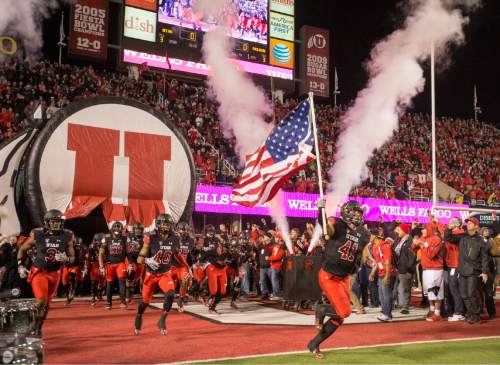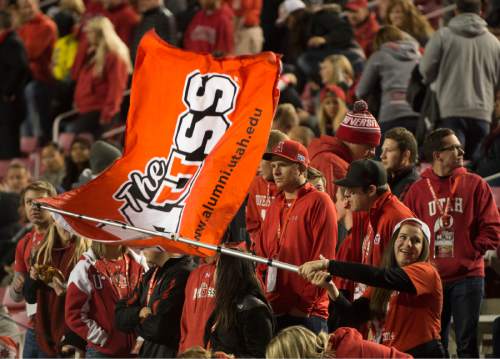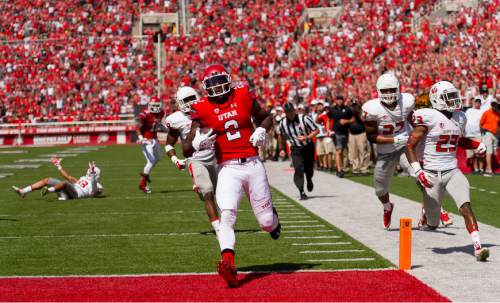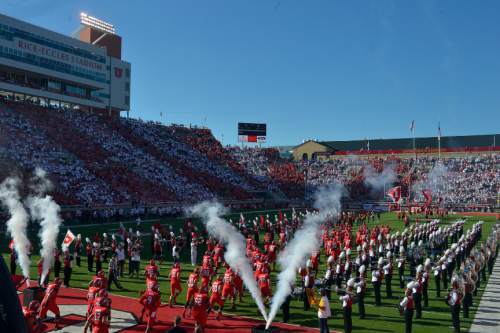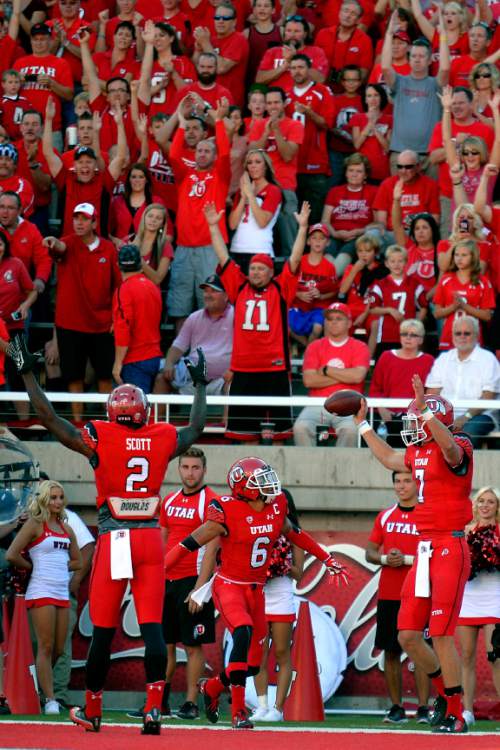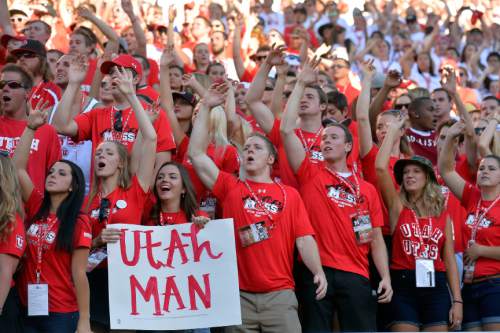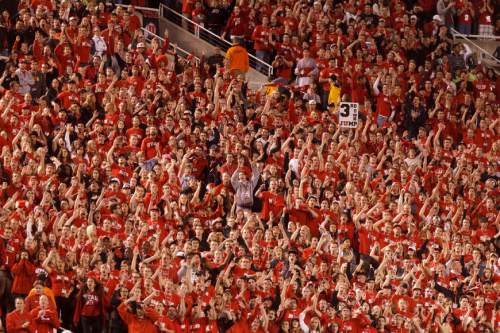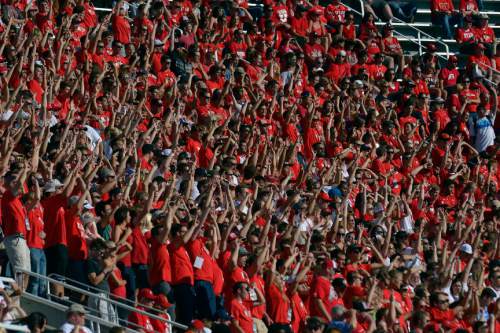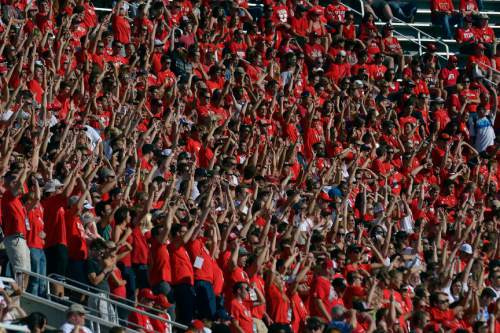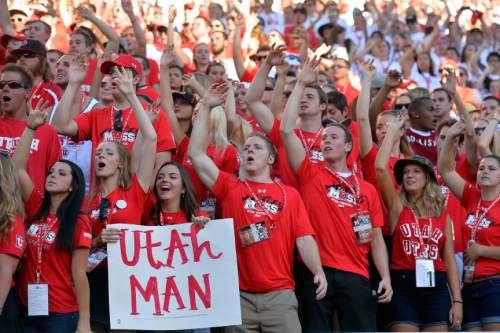This is an archived article that was published on sltrib.com in 2014, and information in the article may be outdated. It is provided only for personal research purposes and may not be reprinted.
Chris Hill hired Rick Majerus, Urban Meyer and Kyle Whittingham, and presided over Utah athletics during its transition from mid-major to Pac-12.
Then, he put the brakes on progress.
This would be his bio, as written by a subset of Utah fans who feel adamant that Rice-Eccles Stadium should expand, and that Utah's athletics director stands in the way of the bulldozers.
Daniel Olson, a founding member of the Mighty Utah Student Section, is part of a vocal group that would like to see the south end zone torn down and raised anew — filling in the open corners of the bowl with thousands of new seats.
"It would be a great bookend to Rice-Eccles Stadium to have both the south and north end zones being the two loudest parts in the stadium," he said.
Adds fan Jeff Ross: 10,000 more seats would put Utah on a par with the capacity at other Pac-12 schools.
And it's about time, he said. "It still kind of looks Mountain West-esque."
The needed funds could be raised by reaching out to more casual fans, who are less inclined to donate to the school's Crimson Club Athletic Fund, believes fifth-generation Utah fan Cameron Draper. And construction costs are only going to increase.
"I think [Hill] pointing at the money is him hiding. I think it needs to happen and it needs to happen now, while the fan base is hot."
In his office, Hill smiles, and shrugs, and sighs.
"It doesn't go away. This is never going to go away with our fans, I'm convinced."
Not until Rice-Eccles is expanded, at least.
Utah's is one of the hottest tickets in college football.
The Utes have played to 30 consecutive sellouts. For the seventh straight season, all 32,000 season tickets were sold, with a 98 percent renewal rate. The general public can't buy season tickets at face value: Should you want to join those 32,000, it requires a hefty donation to the Crimson Club.
Jacob Johnson said he and his family own 15 season tickets, and as the family grows, they need more.
"We keep asking for more, and every year, we keep getting denied because there's not any," he said.
Hill said he understands these complaints. He believes single-game tickets are not hard to come by, but he hopes a waiting list will soon be established to help would-be season ticket buyers like Johnson's family.
What he doesn't understand are the other arguments. The idea that bigger is better.
"There's an illusion that the size of your stadium equals the prestige of your program," he said.
Hill said visiting athletic directors frequently tell him Rice-Eccles is just right, and "Don't you dare expand it."
A 10,000-seat expansion would cost $50-$60 million, he estimates. The U. would need to generate an additional $4-$5 million from season tickets just to break even.
Despite that, he's not saying it won't happen.
While Utah's average attendance, 46,559, ranks just 48th in the nation, its attendance by percent of capacity, 102 percent, is seventh. Of Pac-12 teams, only nation-leading Oregon (at 106.8 percent) ranks higher.
The decision does not fall to Hill alone, but the blame does. Though Utah athletics rents the stadium from the U., there exists a popular belief that the south end zone will be rebuilt as soon as Hill retires.
Not helping that perception is that Hill has been the U.'s point person during three signs of seemingly imminent expansion:
1 • A report from the Utah Olympic Exploratory Committee, presented to Gov. Gary Herbert and Salt Lake City Mayor Ralph Becker in October 2012, that reads, "The Olympic Stadium (Rice-Eccles) is scheduled for expansion from 45,000 to 55,000 seats, a project that is contemplated within the next 2-3 years."
2 • A rendering commissioned by the university's campus planning office that shows a filled-in south end zone crowned by box and loge (theater-style) seating.
3 • The removal of the iconic Hoberman Arch from the south concourse.
Draper said those things "excite the fan base. Then, he's kind of backed off that stance, and that really, really bugs me."
It's not necessarily wrong to read into those signs that the south end zone will one day be filled in, Hill said, "but at the same time, I'm not sure the reason that would turn the corner for us."
More pressing, he added, is the need to increase space on the concourses, build more restrooms and install a $6 million new video board.
Those priorities make sense to Utah fans Brian Ross and Allan Ryther. Ryther recalls seeing 200-foot lines snaking out from the entrance of the men's restroom.
"It's atrocious, and I believe that it's a fire hazard," he said.
Hill believes that if there's a valid complaint about Rice-Eccles Stadium, it's that the fan experience needs to be improved for the current season ticket buyers, who are "the lifeblood of your program."
That will cost $10-$15 million, he said.
Another reason to resist expansion, Hill said, is a fear that younger people are becoming less likely to attend games.
A Wall Street Journal report found that student attendance at college football games dipped 7.1 percent between 2009 and 2013, even as overall attendance rose slightly for some top-tier teams.
"The fear is the proliferation of TV games, the changes of time for people," Hill said. "If you look around the country, the data is not giving you information that crowds are growing."
It may be that Utah's lively MUSS has bucked this trend, but it's hard to ignore the broader cultural shift, Hill said.
Utah hopes to address this somewhat by improving spotty and sometimes nonexistent cellphone coverage during games, although Hill said it's a problem, "they haven't been able to solve in too many places."
Fan experience aside, Hill loves the atmosphere at Rice-Eccles on game days. He recalls the advice of Ohio State athletic director and friend Gene Smith, who told him, "Outside of winning, when you are an athletic director and you can walk to the stadium, and you know it's going to be full, that's the start to a good day."
If he has to play the villain, he said, so be it.
"I'd rather have people talking about expanding the size of our stadium than reducing the size of our stadium. If I've got a choice in life, I'd rather have that."
Twitter: @matthew_piper —
Rice-Eccles vs. the Pac-12
Attendance by capacity, in 2014 • Second, at 102%, behind Oregon (106.8%) and ahead of Stanford (95.7%), Washington State (92.7%), Washington (91.85%), Oregon State (91.1%), Arizona (88.9%), Arizona State (86.2%), UCLA (84.2%), USC (76.9%), Cal (72.7%) and Colorado (70%).
Capacity • Eleventh, at 45,634, ahead of only Washington State (32,740). 1. USC, 93,607; 2. UCLA, 91,136; 3. Washington, 70,138; Arizona State, 67,704; Cal, 62,467; Arizona, 56,037; Oregon, 54,000; Colorado, 53,613; Stanford, 50,000; Oregon State, 45,674.
Source: NCAA — Some capacity numbers differ slightly from those publicized by schools —
The rest of the PAC
Some of the appetite for Rice-Eccles Stadium expansion no doubt stems from other lavish stadium upgrades in the Pac-12. More than half the conference's schools have spent tens of millions to improve their football stadiums in recent years, and a survey released in August by AECOM found that eight in 10 college athletic directors have planned major facilities investments.
They are not all expansions, though. Projects at Arizona, Arizona State, Cal, Stanford and Washington actually reduced total seating capacity (Utah athletic director Chris Hill can cite the capacities of these stadiums off the top of his head). And the AECOM survey notes that a majority of the upgrades center on enhancing fan experience and adding premium seating. Not on overall capacity.
Arizona State chief of staff Rocky Harris said that his school's situation is unique: Sun Devil Stadium was built when ASU was the only show in town, before four professional sports teams moved in. But ultimately, the idea was to sell more season tickets and increase renewal rates — which you do by making tickets harder to come by.
"I understand why fans want a larger stadium," he said. "It sounds really cool. But do they want a large, half-empty stadium, or do they want a midsize stadium where it's hard to play?"
A $256 million renovation has already begun at Sun Devil Stadium, which will go from 71,706 to somewhere between 55,000 and 60,000.
Harris, an ASU alum, admits he had some "heartburn" hearing about a reduction before he joined the staff a few years ago. But when he heard firsthand the reasons, and drawing upon what he learned working for Major League Soccer's Houston Dynamo, he began to see the sense in building a stadium that Arizona State can fill for every game, and not just for the top-ranked opponents, or the rival Wildcats.
When the renovation is complete, ASU hopes that Sun Devil Stadium will be well-positioned for a changing landscape and unpredictable fortunes. To do that, he said, they're aiming to provide a more premium fan experience.
And empty seats are not a part of that experience.
"Attendance overall is dropping, and the broadcast ratings are going up," Harris said. "What we have to do is stop focusing on the masses, and [start] using our money in the best way possible."


